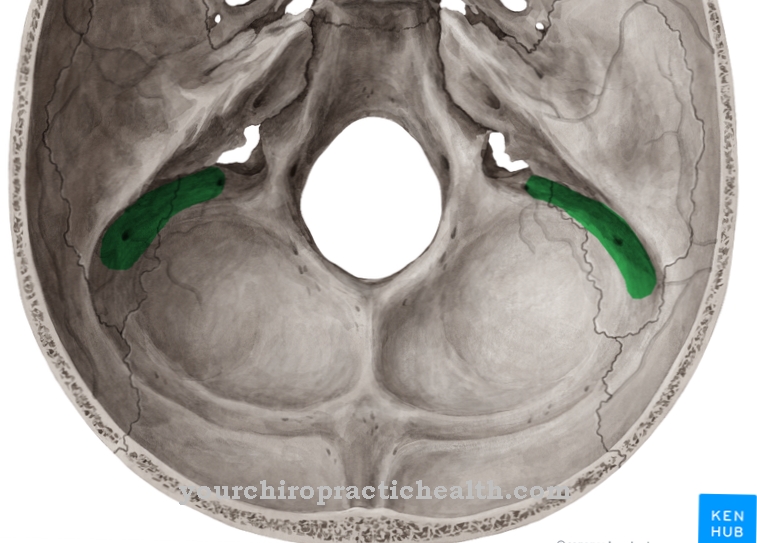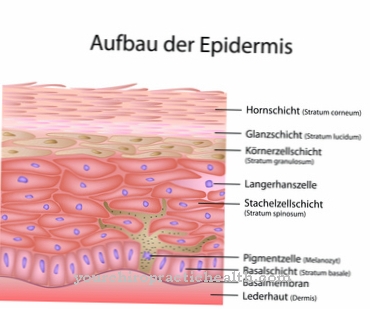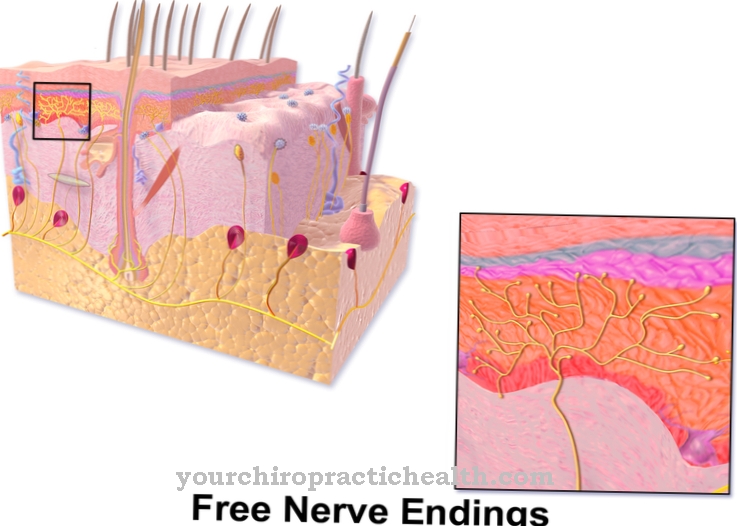Of the Locus caeruleus is part of the reticular formation in the bridge (pons) and consists of four nuclei.
Its connections to the forebrain (prosencephalon), interbrain (diencephalon), brain stem (truncus cerebri), cerebellum (cerebellum) and spinal cord are involved in specific arousal processes. Neurodegenerative diseases such as Alzheimer's dementia, Down's syndrome or Parkinson's syndrome can damage the locus caeruleus, which also plays a role in various mental illnesses.
What is the Locus caeruleus?
The locus caeruleus is part of the central nervous system. It lies in the bridge (pons), which in turn belongs to the hindbrain (metencephalon) and thus to the hindbrain (rhombencephalon). Functionally, the locus caeruleus can be assigned to the ascending reticular activation system (ARAS).
The name of the Locus caeruleus comes from Latin and translates as "sky-blue place". The name goes back to the coloration in this brain region, which early anatomists found in their investigations and which goes back to pigments. Other spellings for the Locus caeruleus are Locus coeruleus and Locus ceruleus.
Anatomy & structure
The locus caeruleus is on the border with the mesencephalon near the fourth cerebral ventricle. It belongs to the bridge (pons) that connects the elongated spinal cord (medulla oblongata) with the midbrain (mesencephalon).
Within the pons, the locus caeruleus represents part of the formatio reticularis. It is a network of different core areas and nerve tracts that run through the entire brain stem (midbrain, bridge and elongated medulla).
Four structures join together to form the locus caeruleus, in the middle of which lies the central nucleus; its tissue is clearly demarcated from the surrounding areas. The anterior nucleus is located in the anterior part of the locus caeruleus, while the dorsal subnucleus is located in the posterior area. The fourth part of the locus caeruleus is the nucleus subcaeruleus, which some definitions regard as a separate area. Numerous nerve fibers connect the locus caeruleus with structures in the forebrain (prosencephalon), diencephalon, brain stem (truncus cerebri), cerebellum (cerebellum) and spinal cord. These neural pathways play a crucial role in the function of the locus caeruleus.
Function & tasks
Originally, researchers assumed that the locus caeruleus played a non-specific role in controlling the arousal. In fact, however, the functions of the locus caeruleus are both more extensive and more specific than initially assumed. Norepinephrine occurs as the most important neurotransmitter of the locus caeruleus, where it can bind to various adrenal receptors and thus trigger an electrical signal in the downstream nerve cell.
The connections between the prosencephalon and the locus caeruleus include nerve fibers that connect the structure in the pons with the neocortex. The neocortex belongs to the cerebral cortex (Cortex cerebri) and embodies its youngest area from an evolutionary perspective. An activation in the locus caeruleus is accompanied by an increase in activity in the neocortex and is reflected in the subjective experience according to the current state of knowledge as increased alertness. This function of the locus caeruleus also contributes to the general arousal.
Other fibers lead to the pars basalis telencephali and are there also involved in wakefulness and arousal. Furthermore, the locus caeruleus is connected to the limbic system, which is responsible for emotional processes. Crucial structures include the hippocampus, which is important for memory function, and the amygdala, the activity of which is correlated with fear.
Nerve pathways between the locus caeruleus and the brainstem form a connection to motor and premotor functions, sensory processing, parasympathetic activity and alertness.In the diencephalon, nerve fibers from the locus caeruleus end at the thalamus and hypothalamus; the cerebellum, whose tasks include movement control and coordination, is also connected to the locus caeruleus. Some fibers, which originate in the locus caeruleus, pass directly to the spinal cord.
You can find your medication here
➔ Medication for shortness of breath and lung problemsDiseases
Various nervous diseases can affect the locus caeruleus. Medicine summarizes clinical pictures as neurodegenerative diseases, which are characterized by the loss of nerve cells.
One example of this is Alzheimer's dementia, which is characterized by the progressive loss of neurons. The degeneration leads to various psychological and neurological symptoms, including memory disorders, agnosia, language and speech disorders and the inability to perform (even simple) practical tasks. Especially in the third and final stage, those affected suffer from apathy and are usually bedridden. The exact cause of Alzheimer's dementia is still unknown. The three leading hypotheses assume a disorder associated with plaques, neurofibrils, or specific glial cells that trigger, accompany, or follow the atrophy of nerve cells.
Down syndrome can also be associated with an impairment of the locus caeruleus. The congenital disease is based on a genetic error: Affected people have a third chromosome 21. For this reason, Down's syndrome is also known as trisomy 21.
In the context of Parkinson's syndrome, the locus caeruleus can also be affected. The clinical picture manifests itself in the form of four cardinal symptoms: muscle tremors (tremor), muscle stiffness (rigidity), slowing of movements (bradykinesia) and postural instability (postural instability). At least bradykinesia and one other core symptom must occur for a diagnosis. The symptoms are due to the loss of the substantia nigra, which is part of the extrapyramidal motor system.
The locus caeruleus also appears to be associated with various mental illnesses. Anomalies were found, for example, in the context of depression, anxiety disorders, panic disorder and stress. In addition, the locus caeruleus contributes to the development of physical substance dependence; Researchers were able to show a corresponding correlation for opiates and alcohol.
























.jpg)



